NEXT plc: A Comprehensive Report on Brazil Market Expansion Strategy
VerifiedAdded on 2020/10/05
|9
|2117
|419
Report
AI Summary
This report examines NEXT plc's proposed expansion into the Brazilian market, providing a comprehensive analysis of the company's strengths, weaknesses, opportunities, and threats (SWOT). It delves into the marketing environment using PESTLE analysis, assessing political, economic, social, technological, environmental, and legal factors. The report evaluates market competitiveness through Porter's Five Forces model and justifies the market choice and target segment using the STP model (segmentation, targeting, and positioning). It explores various market entry strategies, including exporting and licensing, and concludes with recommendations for NEXT plc's successful entry into the Brazilian market. The report also includes an executive summary, introduction, conclusion, and references to support the analysis.
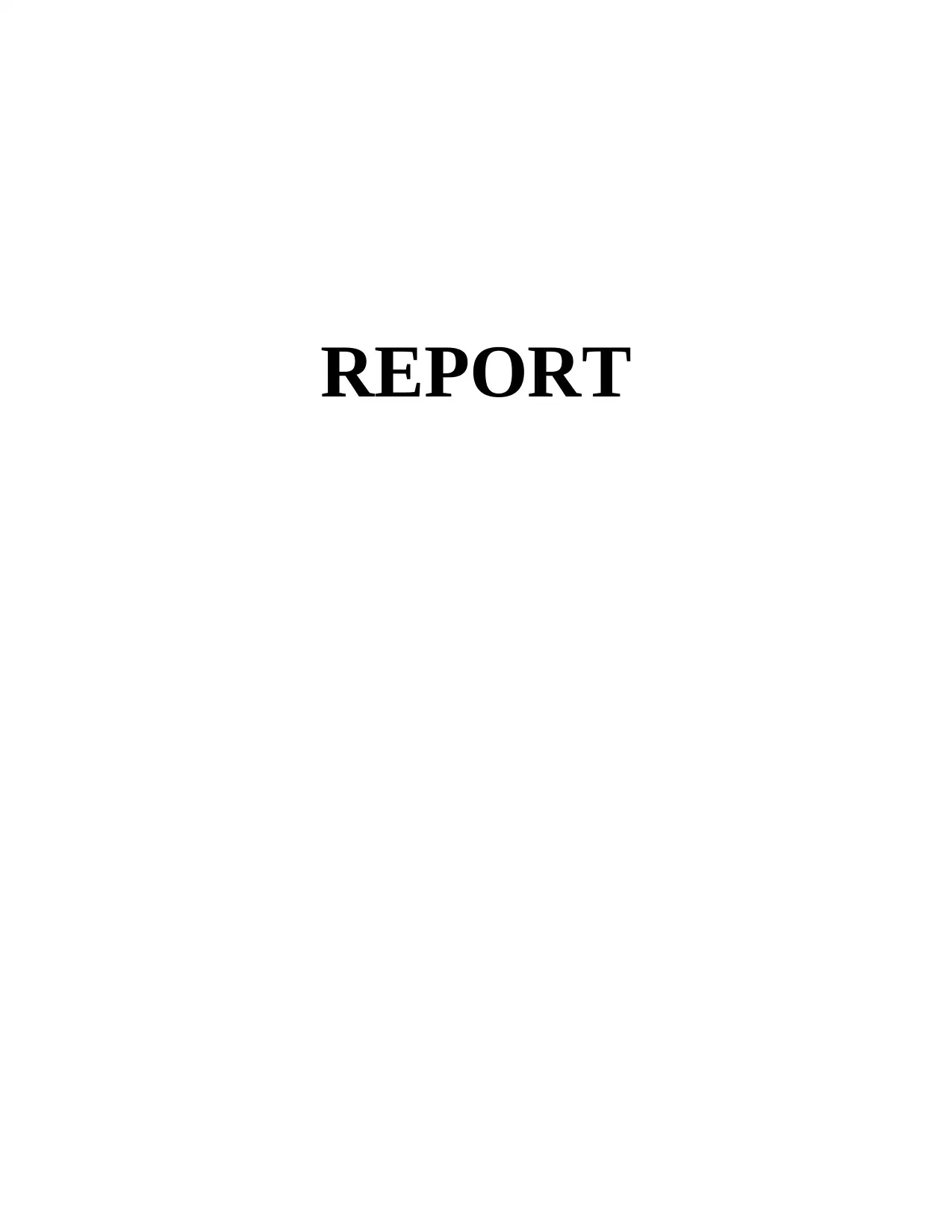
REPORT
Paraphrase This Document
Need a fresh take? Get an instant paraphrase of this document with our AI Paraphraser
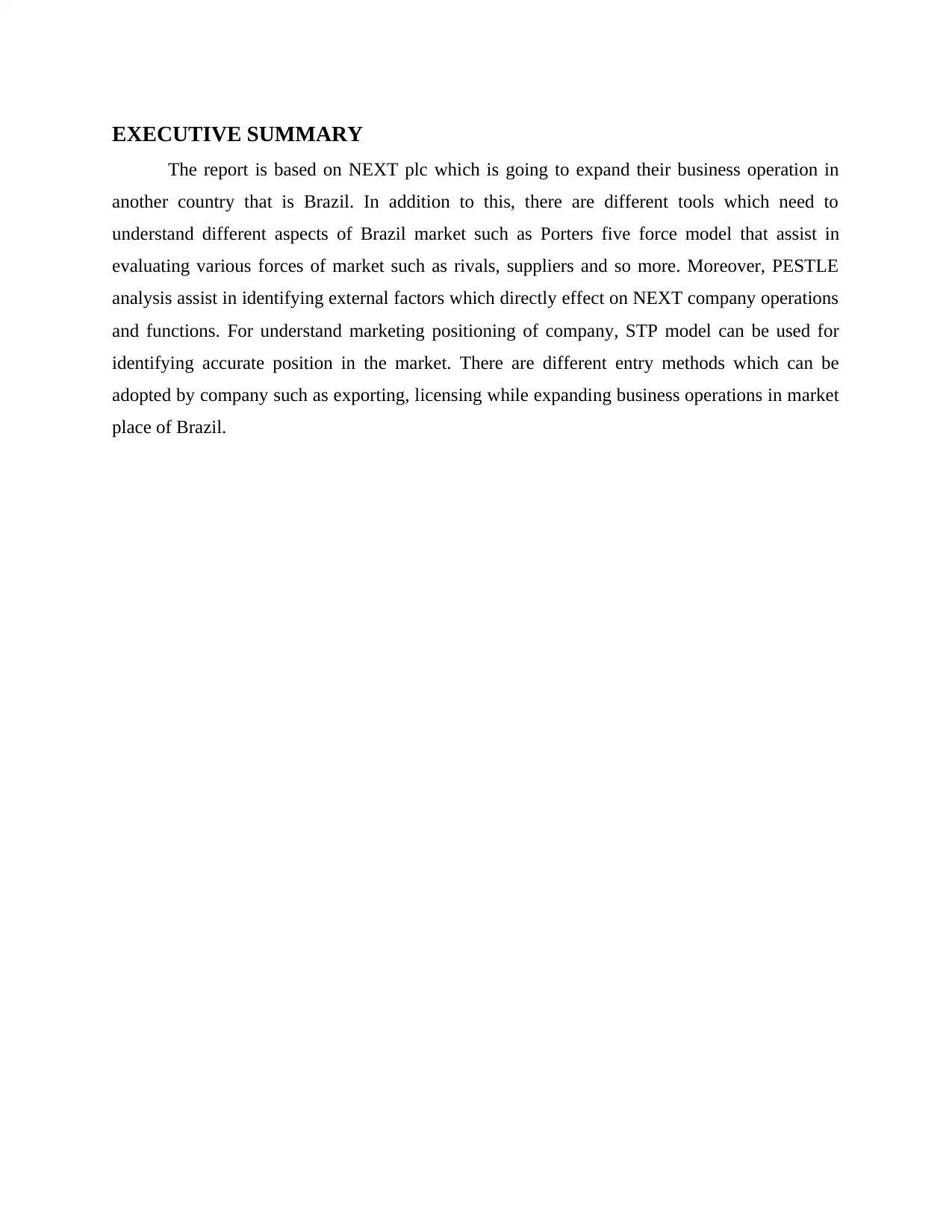
EXECUTIVE SUMMARY
The report is based on NEXT plc which is going to expand their business operation in
another country that is Brazil. In addition to this, there are different tools which need to
understand different aspects of Brazil market such as Porters five force model that assist in
evaluating various forces of market such as rivals, suppliers and so more. Moreover, PESTLE
analysis assist in identifying external factors which directly effect on NEXT company operations
and functions. For understand marketing positioning of company, STP model can be used for
identifying accurate position in the market. There are different entry methods which can be
adopted by company such as exporting, licensing while expanding business operations in market
place of Brazil.
The report is based on NEXT plc which is going to expand their business operation in
another country that is Brazil. In addition to this, there are different tools which need to
understand different aspects of Brazil market such as Porters five force model that assist in
evaluating various forces of market such as rivals, suppliers and so more. Moreover, PESTLE
analysis assist in identifying external factors which directly effect on NEXT company operations
and functions. For understand marketing positioning of company, STP model can be used for
identifying accurate position in the market. There are different entry methods which can be
adopted by company such as exporting, licensing while expanding business operations in market
place of Brazil.
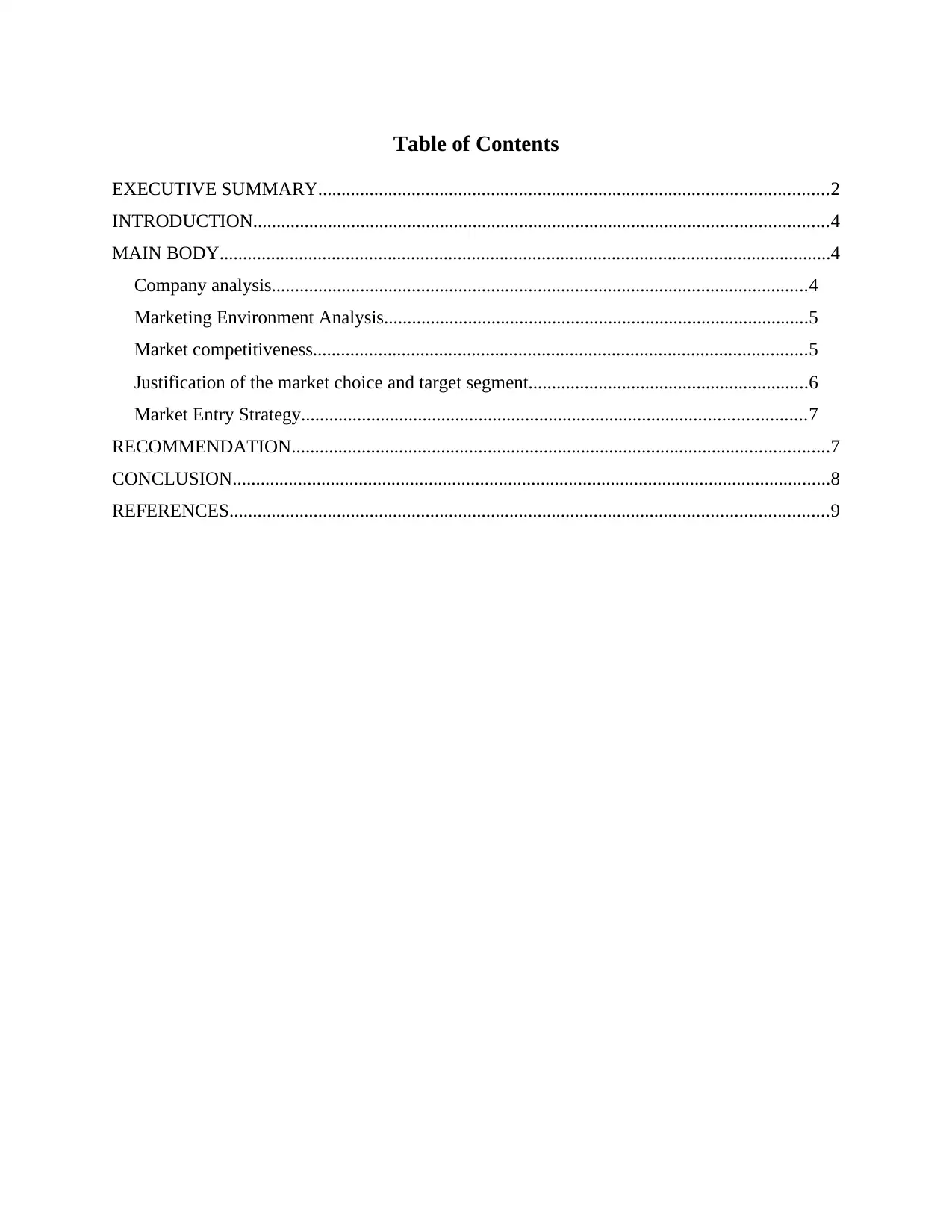
Table of Contents
EXECUTIVE SUMMARY.............................................................................................................2
INTRODUCTION...........................................................................................................................4
MAIN BODY...................................................................................................................................4
Company analysis...................................................................................................................4
Marketing Environment Analysis...........................................................................................5
Market competitiveness..........................................................................................................5
Justification of the market choice and target segment............................................................6
Market Entry Strategy............................................................................................................7
RECOMMENDATION...................................................................................................................7
CONCLUSION................................................................................................................................8
REFERENCES................................................................................................................................9
EXECUTIVE SUMMARY.............................................................................................................2
INTRODUCTION...........................................................................................................................4
MAIN BODY...................................................................................................................................4
Company analysis...................................................................................................................4
Marketing Environment Analysis...........................................................................................5
Market competitiveness..........................................................................................................5
Justification of the market choice and target segment............................................................6
Market Entry Strategy............................................................................................................7
RECOMMENDATION...................................................................................................................7
CONCLUSION................................................................................................................................8
REFERENCES................................................................................................................................9
⊘ This is a preview!⊘
Do you want full access?
Subscribe today to unlock all pages.

Trusted by 1+ million students worldwide
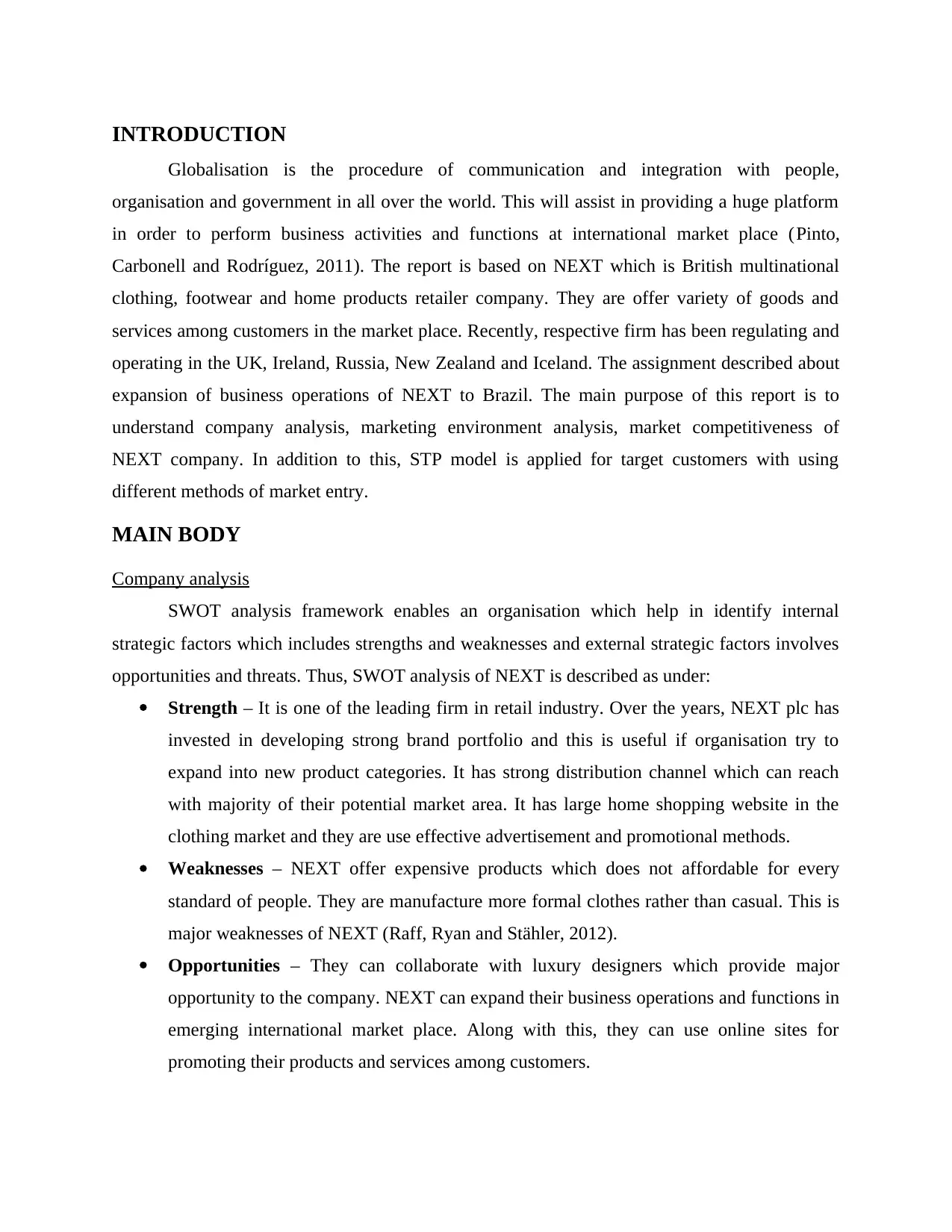
INTRODUCTION
Globalisation is the procedure of communication and integration with people,
organisation and government in all over the world. This will assist in providing a huge platform
in order to perform business activities and functions at international market place (Pinto,
Carbonell and Rodríguez, 2011). The report is based on NEXT which is British multinational
clothing, footwear and home products retailer company. They are offer variety of goods and
services among customers in the market place. Recently, respective firm has been regulating and
operating in the UK, Ireland, Russia, New Zealand and Iceland. The assignment described about
expansion of business operations of NEXT to Brazil. The main purpose of this report is to
understand company analysis, marketing environment analysis, market competitiveness of
NEXT company. In addition to this, STP model is applied for target customers with using
different methods of market entry.
MAIN BODY
Company analysis
SWOT analysis framework enables an organisation which help in identify internal
strategic factors which includes strengths and weaknesses and external strategic factors involves
opportunities and threats. Thus, SWOT analysis of NEXT is described as under:
Strength – It is one of the leading firm in retail industry. Over the years, NEXT plc has
invested in developing strong brand portfolio and this is useful if organisation try to
expand into new product categories. It has strong distribution channel which can reach
with majority of their potential market area. It has large home shopping website in the
clothing market and they are use effective advertisement and promotional methods.
Weaknesses – NEXT offer expensive products which does not affordable for every
standard of people. They are manufacture more formal clothes rather than casual. This is
major weaknesses of NEXT (Raff, Ryan and Stähler, 2012).
Opportunities – They can collaborate with luxury designers which provide major
opportunity to the company. NEXT can expand their business operations and functions in
emerging international market place. Along with this, they can use online sites for
promoting their products and services among customers.
Globalisation is the procedure of communication and integration with people,
organisation and government in all over the world. This will assist in providing a huge platform
in order to perform business activities and functions at international market place (Pinto,
Carbonell and Rodríguez, 2011). The report is based on NEXT which is British multinational
clothing, footwear and home products retailer company. They are offer variety of goods and
services among customers in the market place. Recently, respective firm has been regulating and
operating in the UK, Ireland, Russia, New Zealand and Iceland. The assignment described about
expansion of business operations of NEXT to Brazil. The main purpose of this report is to
understand company analysis, marketing environment analysis, market competitiveness of
NEXT company. In addition to this, STP model is applied for target customers with using
different methods of market entry.
MAIN BODY
Company analysis
SWOT analysis framework enables an organisation which help in identify internal
strategic factors which includes strengths and weaknesses and external strategic factors involves
opportunities and threats. Thus, SWOT analysis of NEXT is described as under:
Strength – It is one of the leading firm in retail industry. Over the years, NEXT plc has
invested in developing strong brand portfolio and this is useful if organisation try to
expand into new product categories. It has strong distribution channel which can reach
with majority of their potential market area. It has large home shopping website in the
clothing market and they are use effective advertisement and promotional methods.
Weaknesses – NEXT offer expensive products which does not affordable for every
standard of people. They are manufacture more formal clothes rather than casual. This is
major weaknesses of NEXT (Raff, Ryan and Stähler, 2012).
Opportunities – They can collaborate with luxury designers which provide major
opportunity to the company. NEXT can expand their business operations and functions in
emerging international market place. Along with this, they can use online sites for
promoting their products and services among customers.
Paraphrase This Document
Need a fresh take? Get an instant paraphrase of this document with our AI Paraphraser
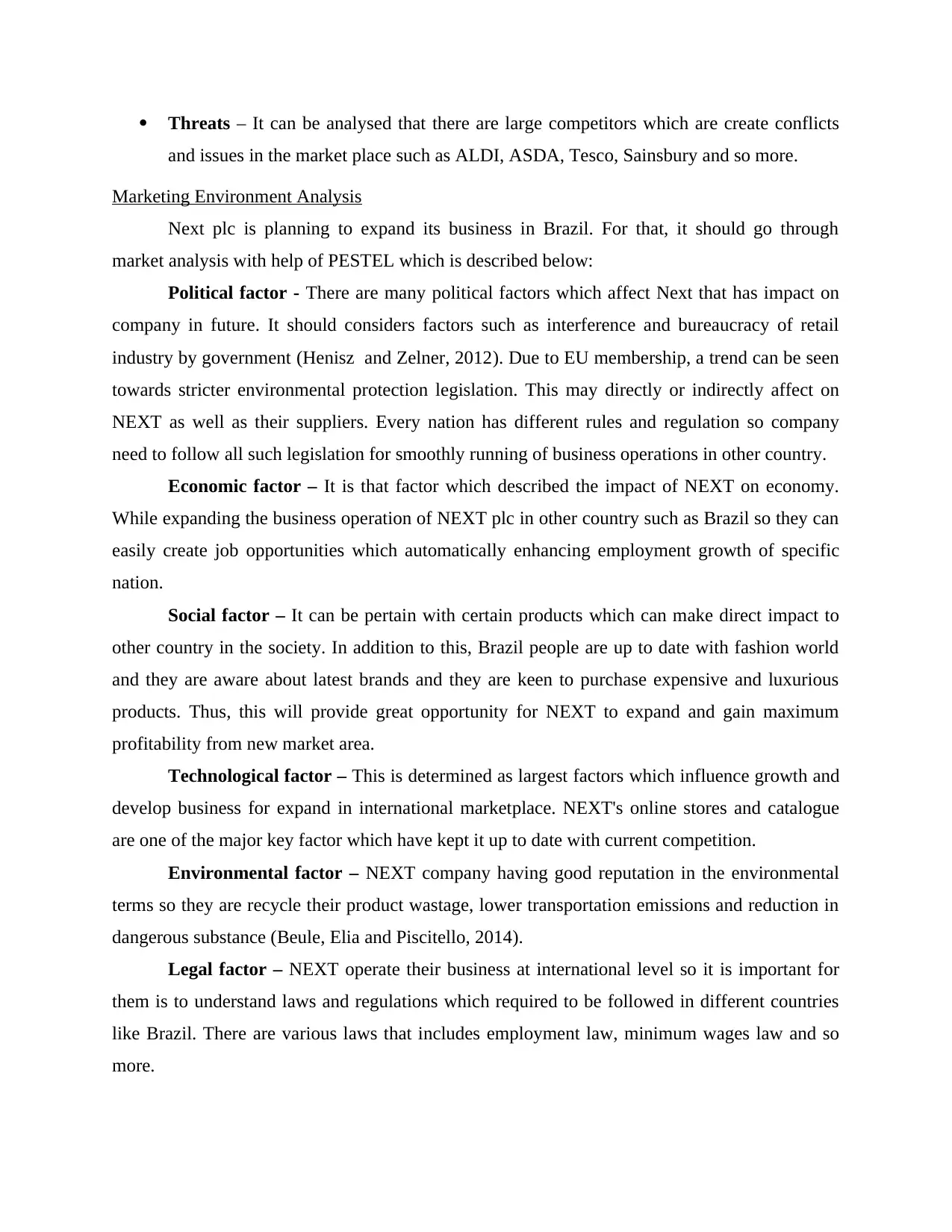
Threats – It can be analysed that there are large competitors which are create conflicts
and issues in the market place such as ALDI, ASDA, Tesco, Sainsbury and so more.
Marketing Environment Analysis
Next plc is planning to expand its business in Brazil. For that, it should go through
market analysis with help of PESTEL which is described below:
Political factor - There are many political factors which affect Next that has impact on
company in future. It should considers factors such as interference and bureaucracy of retail
industry by government (Henisz and Zelner, 2012). Due to EU membership, a trend can be seen
towards stricter environmental protection legislation. This may directly or indirectly affect on
NEXT as well as their suppliers. Every nation has different rules and regulation so company
need to follow all such legislation for smoothly running of business operations in other country.
Economic factor – It is that factor which described the impact of NEXT on economy.
While expanding the business operation of NEXT plc in other country such as Brazil so they can
easily create job opportunities which automatically enhancing employment growth of specific
nation.
Social factor – It can be pertain with certain products which can make direct impact to
other country in the society. In addition to this, Brazil people are up to date with fashion world
and they are aware about latest brands and they are keen to purchase expensive and luxurious
products. Thus, this will provide great opportunity for NEXT to expand and gain maximum
profitability from new market area.
Technological factor – This is determined as largest factors which influence growth and
develop business for expand in international marketplace. NEXT's online stores and catalogue
are one of the major key factor which have kept it up to date with current competition.
Environmental factor – NEXT company having good reputation in the environmental
terms so they are recycle their product wastage, lower transportation emissions and reduction in
dangerous substance (Beule, Elia and Piscitello, 2014).
Legal factor – NEXT operate their business at international level so it is important for
them is to understand laws and regulations which required to be followed in different countries
like Brazil. There are various laws that includes employment law, minimum wages law and so
more.
and issues in the market place such as ALDI, ASDA, Tesco, Sainsbury and so more.
Marketing Environment Analysis
Next plc is planning to expand its business in Brazil. For that, it should go through
market analysis with help of PESTEL which is described below:
Political factor - There are many political factors which affect Next that has impact on
company in future. It should considers factors such as interference and bureaucracy of retail
industry by government (Henisz and Zelner, 2012). Due to EU membership, a trend can be seen
towards stricter environmental protection legislation. This may directly or indirectly affect on
NEXT as well as their suppliers. Every nation has different rules and regulation so company
need to follow all such legislation for smoothly running of business operations in other country.
Economic factor – It is that factor which described the impact of NEXT on economy.
While expanding the business operation of NEXT plc in other country such as Brazil so they can
easily create job opportunities which automatically enhancing employment growth of specific
nation.
Social factor – It can be pertain with certain products which can make direct impact to
other country in the society. In addition to this, Brazil people are up to date with fashion world
and they are aware about latest brands and they are keen to purchase expensive and luxurious
products. Thus, this will provide great opportunity for NEXT to expand and gain maximum
profitability from new market area.
Technological factor – This is determined as largest factors which influence growth and
develop business for expand in international marketplace. NEXT's online stores and catalogue
are one of the major key factor which have kept it up to date with current competition.
Environmental factor – NEXT company having good reputation in the environmental
terms so they are recycle their product wastage, lower transportation emissions and reduction in
dangerous substance (Beule, Elia and Piscitello, 2014).
Legal factor – NEXT operate their business at international level so it is important for
them is to understand laws and regulations which required to be followed in different countries
like Brazil. There are various laws that includes employment law, minimum wages law and so
more.
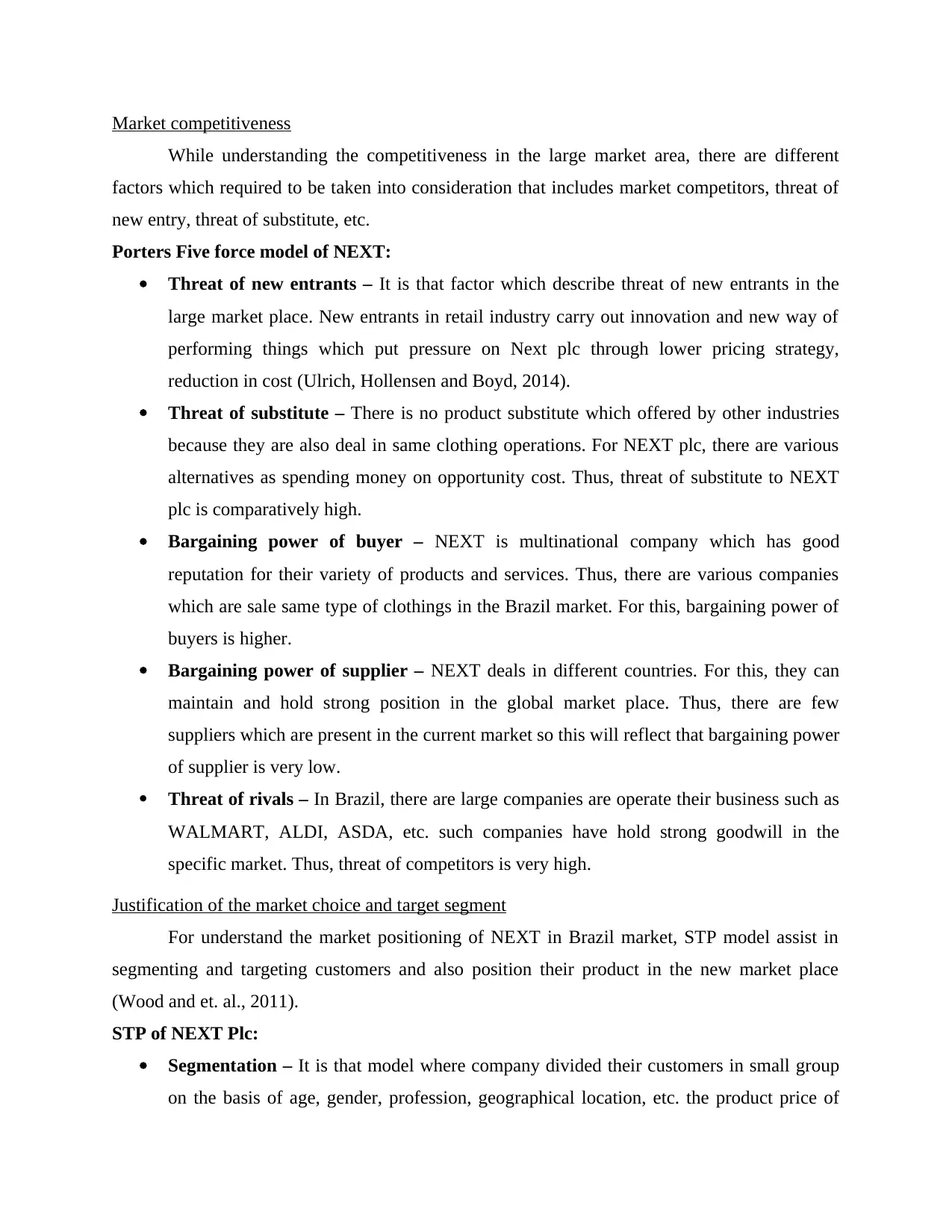
Market competitiveness
While understanding the competitiveness in the large market area, there are different
factors which required to be taken into consideration that includes market competitors, threat of
new entry, threat of substitute, etc.
Porters Five force model of NEXT:
Threat of new entrants – It is that factor which describe threat of new entrants in the
large market place. New entrants in retail industry carry out innovation and new way of
performing things which put pressure on Next plc through lower pricing strategy,
reduction in cost (Ulrich, Hollensen and Boyd, 2014).
Threat of substitute – There is no product substitute which offered by other industries
because they are also deal in same clothing operations. For NEXT plc, there are various
alternatives as spending money on opportunity cost. Thus, threat of substitute to NEXT
plc is comparatively high.
Bargaining power of buyer – NEXT is multinational company which has good
reputation for their variety of products and services. Thus, there are various companies
which are sale same type of clothings in the Brazil market. For this, bargaining power of
buyers is higher.
Bargaining power of supplier – NEXT deals in different countries. For this, they can
maintain and hold strong position in the global market place. Thus, there are few
suppliers which are present in the current market so this will reflect that bargaining power
of supplier is very low.
Threat of rivals – In Brazil, there are large companies are operate their business such as
WALMART, ALDI, ASDA, etc. such companies have hold strong goodwill in the
specific market. Thus, threat of competitors is very high.
Justification of the market choice and target segment
For understand the market positioning of NEXT in Brazil market, STP model assist in
segmenting and targeting customers and also position their product in the new market place
(Wood and et. al., 2011).
STP of NEXT Plc:
Segmentation – It is that model where company divided their customers in small group
on the basis of age, gender, profession, geographical location, etc. the product price of
While understanding the competitiveness in the large market area, there are different
factors which required to be taken into consideration that includes market competitors, threat of
new entry, threat of substitute, etc.
Porters Five force model of NEXT:
Threat of new entrants – It is that factor which describe threat of new entrants in the
large market place. New entrants in retail industry carry out innovation and new way of
performing things which put pressure on Next plc through lower pricing strategy,
reduction in cost (Ulrich, Hollensen and Boyd, 2014).
Threat of substitute – There is no product substitute which offered by other industries
because they are also deal in same clothing operations. For NEXT plc, there are various
alternatives as spending money on opportunity cost. Thus, threat of substitute to NEXT
plc is comparatively high.
Bargaining power of buyer – NEXT is multinational company which has good
reputation for their variety of products and services. Thus, there are various companies
which are sale same type of clothings in the Brazil market. For this, bargaining power of
buyers is higher.
Bargaining power of supplier – NEXT deals in different countries. For this, they can
maintain and hold strong position in the global market place. Thus, there are few
suppliers which are present in the current market so this will reflect that bargaining power
of supplier is very low.
Threat of rivals – In Brazil, there are large companies are operate their business such as
WALMART, ALDI, ASDA, etc. such companies have hold strong goodwill in the
specific market. Thus, threat of competitors is very high.
Justification of the market choice and target segment
For understand the market positioning of NEXT in Brazil market, STP model assist in
segmenting and targeting customers and also position their product in the new market place
(Wood and et. al., 2011).
STP of NEXT Plc:
Segmentation – It is that model where company divided their customers in small group
on the basis of age, gender, profession, geographical location, etc. the product price of
⊘ This is a preview!⊘
Do you want full access?
Subscribe today to unlock all pages.

Trusted by 1+ million students worldwide
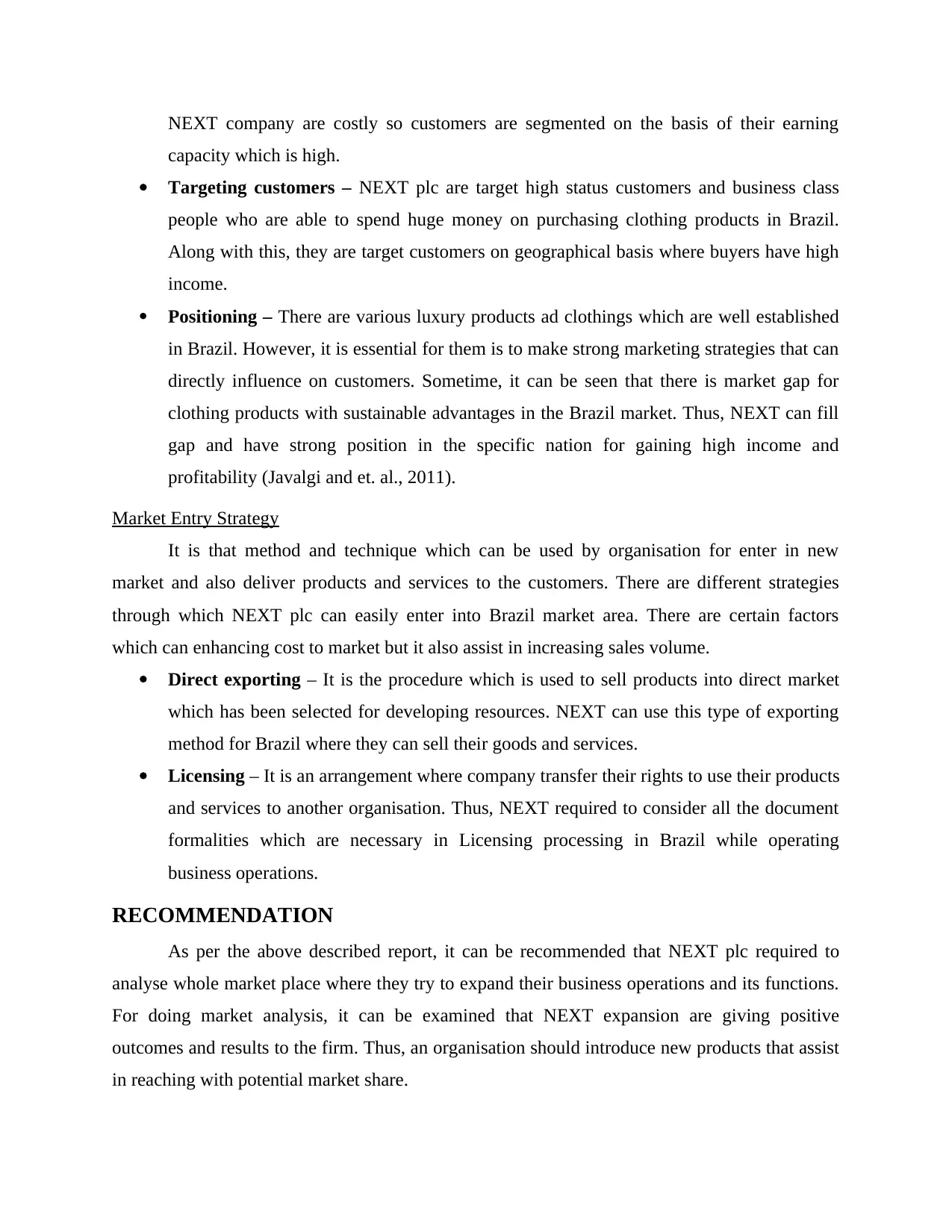
NEXT company are costly so customers are segmented on the basis of their earning
capacity which is high.
Targeting customers – NEXT plc are target high status customers and business class
people who are able to spend huge money on purchasing clothing products in Brazil.
Along with this, they are target customers on geographical basis where buyers have high
income.
Positioning – There are various luxury products ad clothings which are well established
in Brazil. However, it is essential for them is to make strong marketing strategies that can
directly influence on customers. Sometime, it can be seen that there is market gap for
clothing products with sustainable advantages in the Brazil market. Thus, NEXT can fill
gap and have strong position in the specific nation for gaining high income and
profitability (Javalgi and et. al., 2011).
Market Entry Strategy
It is that method and technique which can be used by organisation for enter in new
market and also deliver products and services to the customers. There are different strategies
through which NEXT plc can easily enter into Brazil market area. There are certain factors
which can enhancing cost to market but it also assist in increasing sales volume.
Direct exporting – It is the procedure which is used to sell products into direct market
which has been selected for developing resources. NEXT can use this type of exporting
method for Brazil where they can sell their goods and services.
Licensing – It is an arrangement where company transfer their rights to use their products
and services to another organisation. Thus, NEXT required to consider all the document
formalities which are necessary in Licensing processing in Brazil while operating
business operations.
RECOMMENDATION
As per the above described report, it can be recommended that NEXT plc required to
analyse whole market place where they try to expand their business operations and its functions.
For doing market analysis, it can be examined that NEXT expansion are giving positive
outcomes and results to the firm. Thus, an organisation should introduce new products that assist
in reaching with potential market share.
capacity which is high.
Targeting customers – NEXT plc are target high status customers and business class
people who are able to spend huge money on purchasing clothing products in Brazil.
Along with this, they are target customers on geographical basis where buyers have high
income.
Positioning – There are various luxury products ad clothings which are well established
in Brazil. However, it is essential for them is to make strong marketing strategies that can
directly influence on customers. Sometime, it can be seen that there is market gap for
clothing products with sustainable advantages in the Brazil market. Thus, NEXT can fill
gap and have strong position in the specific nation for gaining high income and
profitability (Javalgi and et. al., 2011).
Market Entry Strategy
It is that method and technique which can be used by organisation for enter in new
market and also deliver products and services to the customers. There are different strategies
through which NEXT plc can easily enter into Brazil market area. There are certain factors
which can enhancing cost to market but it also assist in increasing sales volume.
Direct exporting – It is the procedure which is used to sell products into direct market
which has been selected for developing resources. NEXT can use this type of exporting
method for Brazil where they can sell their goods and services.
Licensing – It is an arrangement where company transfer their rights to use their products
and services to another organisation. Thus, NEXT required to consider all the document
formalities which are necessary in Licensing processing in Brazil while operating
business operations.
RECOMMENDATION
As per the above described report, it can be recommended that NEXT plc required to
analyse whole market place where they try to expand their business operations and its functions.
For doing market analysis, it can be examined that NEXT expansion are giving positive
outcomes and results to the firm. Thus, an organisation should introduce new products that assist
in reaching with potential market share.
Paraphrase This Document
Need a fresh take? Get an instant paraphrase of this document with our AI Paraphraser
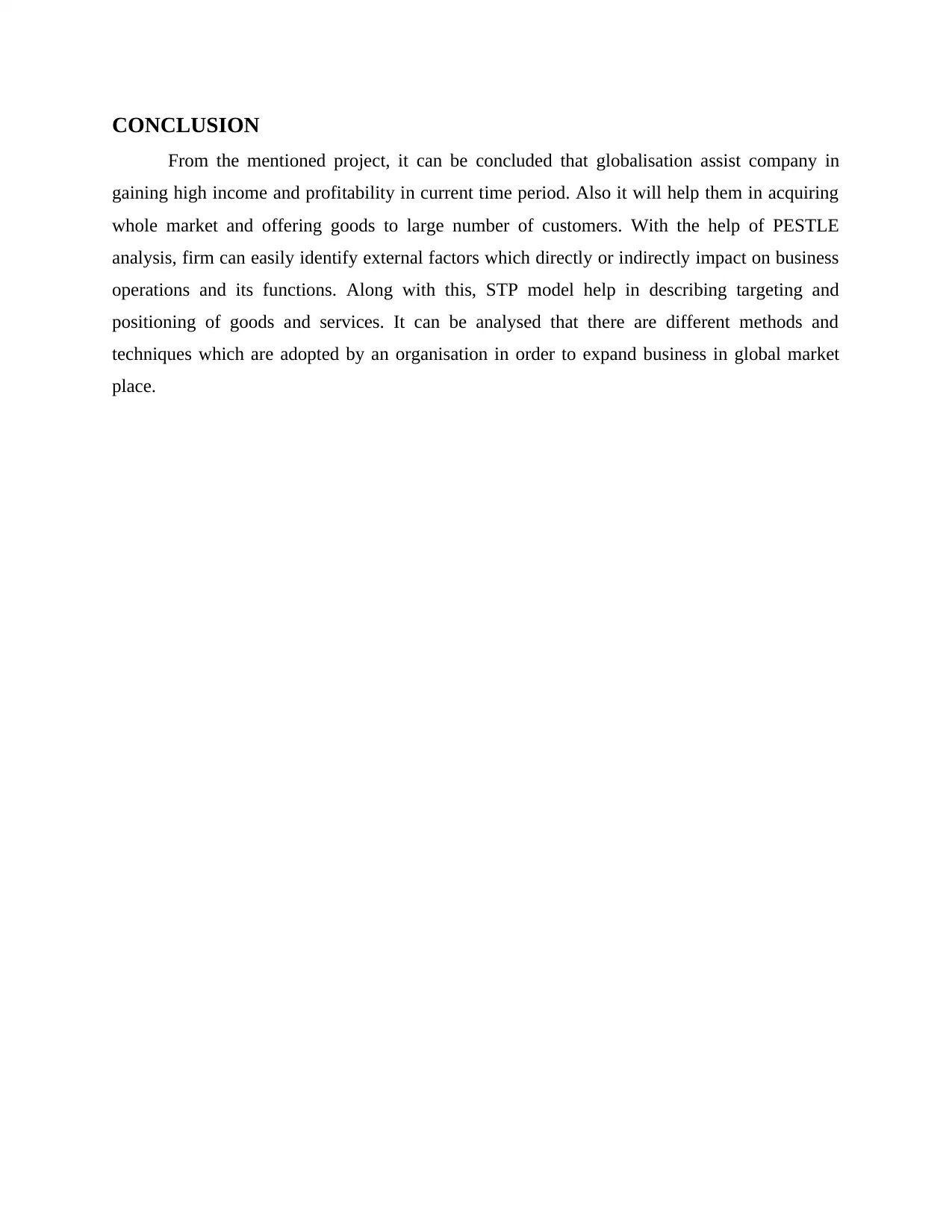
CONCLUSION
From the mentioned project, it can be concluded that globalisation assist company in
gaining high income and profitability in current time period. Also it will help them in acquiring
whole market and offering goods to large number of customers. With the help of PESTLE
analysis, firm can easily identify external factors which directly or indirectly impact on business
operations and its functions. Along with this, STP model help in describing targeting and
positioning of goods and services. It can be analysed that there are different methods and
techniques which are adopted by an organisation in order to expand business in global market
place.
From the mentioned project, it can be concluded that globalisation assist company in
gaining high income and profitability in current time period. Also it will help them in acquiring
whole market and offering goods to large number of customers. With the help of PESTLE
analysis, firm can easily identify external factors which directly or indirectly impact on business
operations and its functions. Along with this, STP model help in describing targeting and
positioning of goods and services. It can be analysed that there are different methods and
techniques which are adopted by an organisation in order to expand business in global market
place.
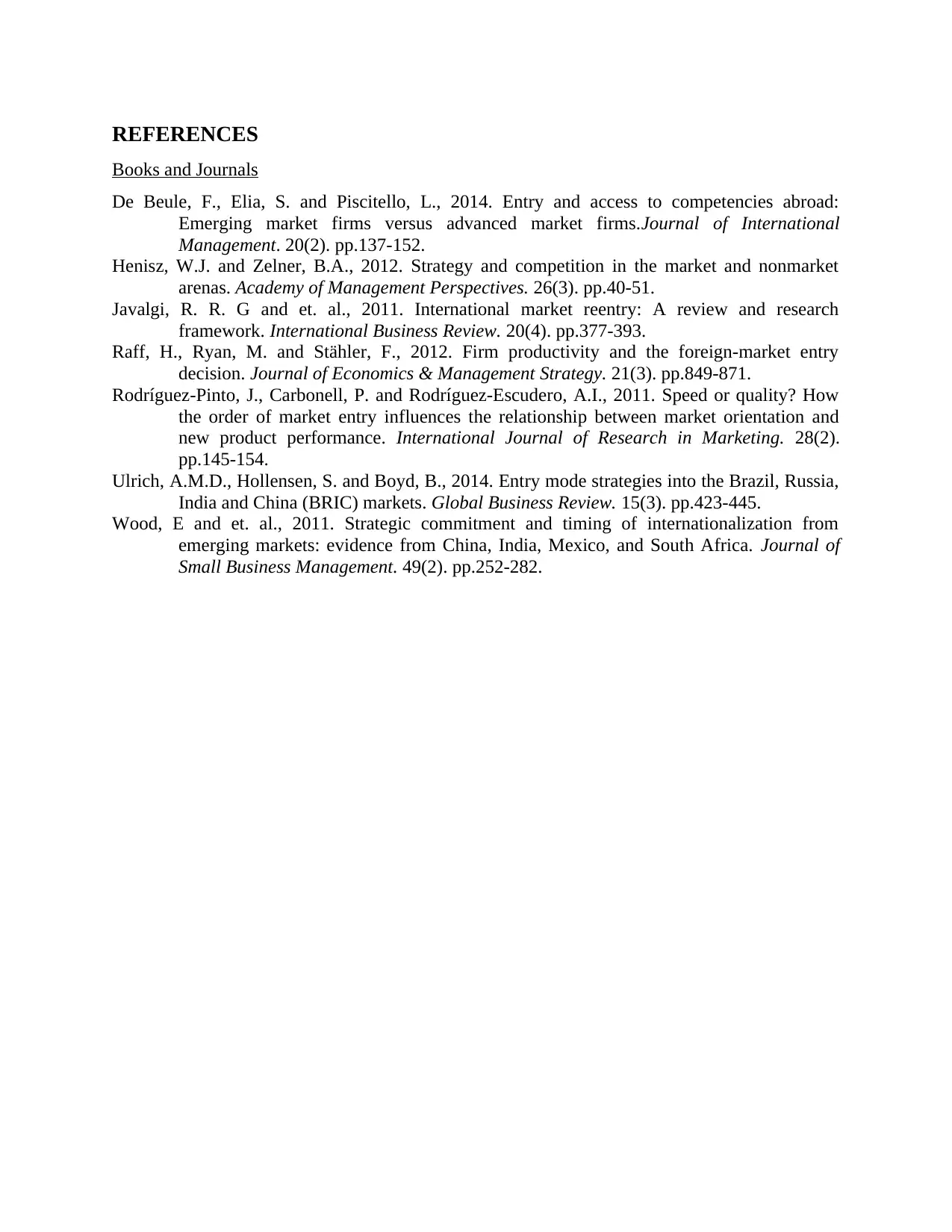
REFERENCES
Books and Journals
De Beule, F., Elia, S. and Piscitello, L., 2014. Entry and access to competencies abroad:
Emerging market firms versus advanced market firms.Journal of International
Management. 20(2). pp.137-152.
Henisz, W.J. and Zelner, B.A., 2012. Strategy and competition in the market and nonmarket
arenas. Academy of Management Perspectives. 26(3). pp.40-51.
Javalgi, R. R. G and et. al., 2011. International market reentry: A review and research
framework. International Business Review. 20(4). pp.377-393.
Raff, H., Ryan, M. and Stähler, F., 2012. Firm productivity and the foreign‐market entry
decision. Journal of Economics & Management Strategy. 21(3). pp.849-871.
Rodríguez-Pinto, J., Carbonell, P. and Rodríguez-Escudero, A.I., 2011. Speed or quality? How
the order of market entry influences the relationship between market orientation and
new product performance. International Journal of Research in Marketing. 28(2).
pp.145-154.
Ulrich, A.M.D., Hollensen, S. and Boyd, B., 2014. Entry mode strategies into the Brazil, Russia,
India and China (BRIC) markets. Global Business Review. 15(3). pp.423-445.
Wood, E and et. al., 2011. Strategic commitment and timing of internationalization from
emerging markets: evidence from China, India, Mexico, and South Africa. Journal of
Small Business Management. 49(2). pp.252-282.
Books and Journals
De Beule, F., Elia, S. and Piscitello, L., 2014. Entry and access to competencies abroad:
Emerging market firms versus advanced market firms.Journal of International
Management. 20(2). pp.137-152.
Henisz, W.J. and Zelner, B.A., 2012. Strategy and competition in the market and nonmarket
arenas. Academy of Management Perspectives. 26(3). pp.40-51.
Javalgi, R. R. G and et. al., 2011. International market reentry: A review and research
framework. International Business Review. 20(4). pp.377-393.
Raff, H., Ryan, M. and Stähler, F., 2012. Firm productivity and the foreign‐market entry
decision. Journal of Economics & Management Strategy. 21(3). pp.849-871.
Rodríguez-Pinto, J., Carbonell, P. and Rodríguez-Escudero, A.I., 2011. Speed or quality? How
the order of market entry influences the relationship between market orientation and
new product performance. International Journal of Research in Marketing. 28(2).
pp.145-154.
Ulrich, A.M.D., Hollensen, S. and Boyd, B., 2014. Entry mode strategies into the Brazil, Russia,
India and China (BRIC) markets. Global Business Review. 15(3). pp.423-445.
Wood, E and et. al., 2011. Strategic commitment and timing of internationalization from
emerging markets: evidence from China, India, Mexico, and South Africa. Journal of
Small Business Management. 49(2). pp.252-282.
⊘ This is a preview!⊘
Do you want full access?
Subscribe today to unlock all pages.

Trusted by 1+ million students worldwide
1 out of 9
Related Documents
Your All-in-One AI-Powered Toolkit for Academic Success.
+13062052269
info@desklib.com
Available 24*7 on WhatsApp / Email
![[object Object]](/_next/static/media/star-bottom.7253800d.svg)
Unlock your academic potential
Copyright © 2020–2025 A2Z Services. All Rights Reserved. Developed and managed by ZUCOL.





